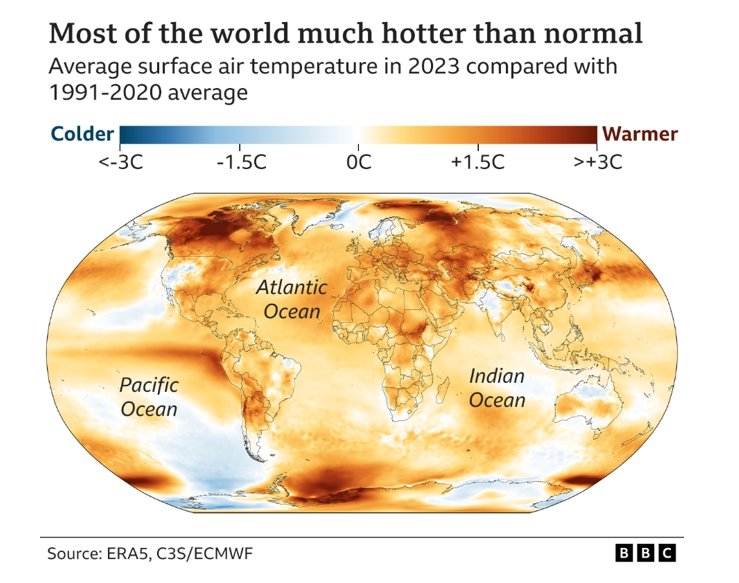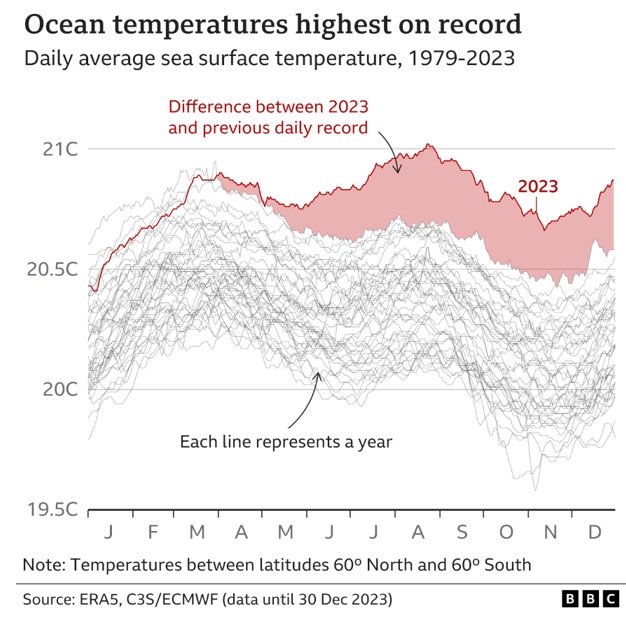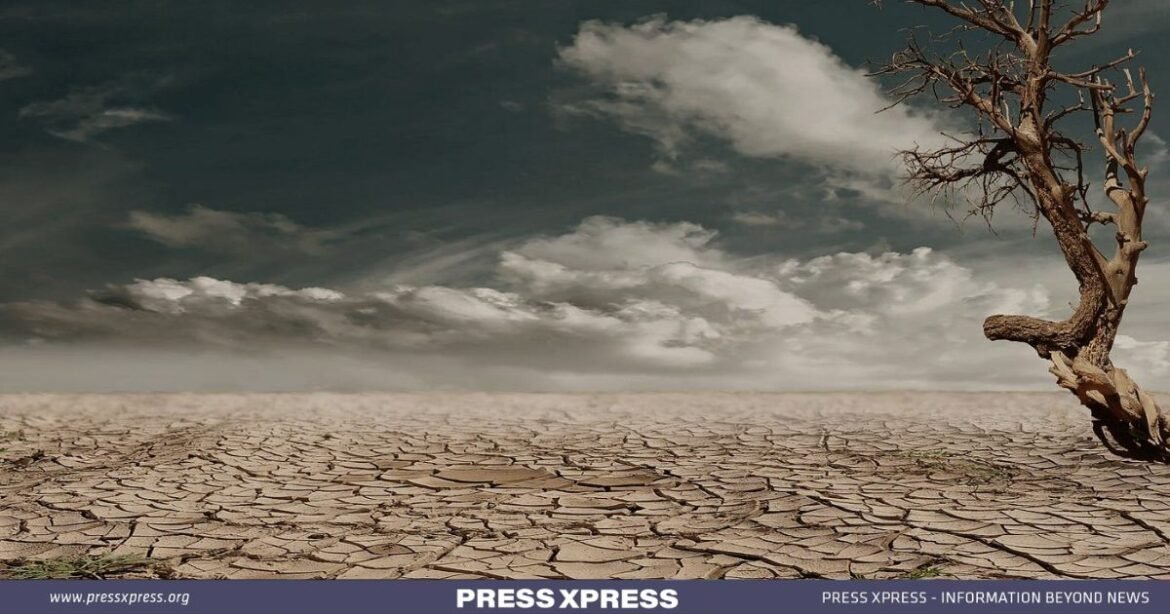Key Facts:
- In 2023, the Earth experienced an average temperature that was 1.48 degrees Celsius higher than during the pre-industrial period
- Bangladesh has faced 185 substantial climate change-induced disasters in the past 20 years
- Bangladesh is the second most vulnerable to the impact of cyclones due to global climate change
The European Union’s Copernicus Climate Change Service (C3S) declared 2023 as the hottest year on record, surpassing previous records and likely the warmest in the last 100,000 years. Global temperatures in 2023 were 1.48 degrees Celsius higher than the pre-industrial period. This exceeds the 1.5-degree Celsius limit set by the Paris Agreement, posing concerns for severe consequences. C3S Director Carlo Buontempo expressed high confidence in the data, noting the year’s exceptional warmth. While the world has not yet exceeded the 1.5-degree threshold on average, temperatures surpassed it on almost half of the days in 2023, emphasizing the urgency of climate action.
You can also read: Is Bangladesh on the Brink of a Blue Biotech Breakthrough?

RECORD CO2 EMISSIONS
Despite intensified global efforts to meet climate targets, CO2 emissions have surged to unprecedented levels, reaching a record high in 2023 due to increased combustion of coal, oil, and gas. C3S highlighted the alarming milestone of CO2 concentration peaking at 419 parts per million. Additionally, 2023 marked the first year with daily temperatures consistently exceeding 1C compared to pre-industrial times, with two November days experiencing a 2C rise. Surpassing 2016 by 0.17C, 2023 set a new temperature record with a “remarkable” margin, as noted by Mr. Buontempo. The El Nino weather phenomenon, amplifying surface water temperatures in the eastern Pacific Ocean, contributed to the heightened global temperatures in 2023, exacerbated by human-caused climate change.
Consequences felt worldwide
The 2023 warmth left an indelible mark on the global landscape, with almost every corner of the world experiencing higher temperatures compared to the 1991-2020 period, which itself was nearly 0.9C warmer than pre-industrial levels.
This unprecedented global warmth not only contributed to intensifying heatwaves and wildfires in Canada and the US but also triggered prolonged droughts followed by devastating floods in parts of East Africa.
These extreme weather events, surpassing the scales observed in recent times, underscore the tangible, destructive impact of climate change on lives and livelihoods. A disconcerting observation is the uninterrupted record-breaking streak in the world’s ocean surface
temperatures since May 4, as revealed by BBC analysis of Copernicus data, with numerous days witnessing remarkable temperature records being shattered by substantial margins, as depicted in the accompanying chart.

Oceans Warming
Scientists have disclosed that an astonishing 90 percent of the excess heat produced by human activities since the industrial age began has been absorbed by the oceans. From July 31 to August 31, global sea surface temperatures, excluding the polar regions, consistently exceeded the previous record from March 2016. Since April, average ocean temperatures have consistently broken seasonal heat records, indicating a concerning pattern.
Beyond amplifying global warming, warming oceans are becoming less effective at absorbing CO2, leading to disruptions in delicate ecosystems. Furthermore, Antarctic Sea ice remains historically low for this period, registering a 12 percent deviation below average in August—the most significant negative anomaly since satellite observations commenced in the 1970s, as reported by C3S.

Anticipated by scientists, the most severe impacts are projected to manifest in late 2023 and beyond, coinciding with the onset of the El Nino weather phenomenon known for elevating temperatures in the South Pacific and beyond. This revelation surfaces amidst global endeavors to restrict temperature increases to a maximum of 2C above pre-industrial levels, with the more ambitious target of 1.5C set at the 2015 Paris climate conference. An imminent report by UN experts will evaluate worldwide progress in meeting these commitments ahead of a pivotal climate summit commencing on November 30 in Dubai. C3S derived these findings through computer-generated analysis incorporating billions of measurements from satellites, ships, global aircraft, as well as proxy data like tree rings and ice cores, and weather stations. This extensive data allows comparisons with temperature records dating back to the 19th century.
Impact On Bangladesh for Global Warming and Climate Change
Over the past two decades, Bangladesh has increasingly witnessed the impacts of climate change, exacerbated by its geographical location and the escalating effects of global warming. The country faces a rising frequency of severe heatwaves, cyclones, floods, droughts, coastal salinity incursions, riverbank erosion, and lightning incidents, disrupting normal life. According to the 2021 Global Climate Risk Index, Bangladesh experienced 185 significant climate change-induced disasters in the last 20 years, resulting in the tragic loss of 11,450 lives and an economic toll of $37.2 billion.
Global warming has heightened the occurrence of cyclones, with coastal areas facing almost annual threats. Despite improving disaster management, coastal residents remain vulnerable. Bangladesh ranks as the second most vulnerable country to cyclones, influenced by rising sea levels and changing river courses due to melting Himalayan glaciers. Increased rainfall, exemplified by severe flash floods in northern regions like Sylhet and Sunamganj, has impacted millions and caused extensive damage to agriculture and livestock. The prolonged closure of educational institutions due to climate change and natural disasters has significantly affected students, with nearly ten thousand institutions temporarily shut last year. Bangladesh is a frontline nation facing heightened flood risks due to climate change.
A warning for 2024 and beyond
The likelihood of 2024 surpassing 2023 in warmth is looming, driven by the potential release of record ocean surface heat into the atmosphere due to the peculiar behavior of the current El Niño, creating uncertainties in predictions, according to Dr. Hausfather. There is a chance that 2024 might breach the critical 1.5°C warming threshold throughout the entire calendar year, as indicated by the UK Met Office. The 2015 Paris Agreement committed nearly 200 countries to limit warming to this level to mitigate the severe impacts of global warming.
Although the Paris Agreement assesses long-term averages over 20 or 30 years, a potential breach in 2024 wouldn’t signify a violation of the accord. However, it underscores the alarming trajectory, with each progressively warmer year pushing the world closer to surpassing the 1.5°C mark over the extended term.
The ongoing global warming trend is primarily attributed to human activities, despite the influence of natural factors like El Niño. The temperatures witnessed in 2023 go beyond natural causes, emphasizing the human-induced aspect of the warming trend. Examining the chart below, while 1998 and 2016 were record-breaking years influenced by robust El Niño warming, they pale in comparison to the new records set in 2023, vividly represented by the darkest red hues.
Actions of Bangladesh Government to face the challenge of climate change
During her address on World Meteorological Day 2023, Prime Minister Sheikh Hasina emphasized Bangladesh’s commendable approach to managing natural disasters, positioning the country as a global exemplar. She highlighted the ongoing Bangladesh Regional Meteorological and Climate Services Project (Component A), aligned with ‘Vision 2041,’ stressing its commitment to delivering improved, science-based weather and climate forecasts. Sheikh Hasina expressed confidence that successful project implementation would markedly enhance the quality of weather services.
The Prime Minister urged continuous readiness to face any calamity, whether natural or man-made. She discussed the broader strategy, including the formulation of the 100-year Bangladesh Delta Plan-2100 and the Eighth Five-Year Plan, both prioritizing climate change and disaster mitigation. Recognizing the global rise in man-made disasters, Sheikh Hasina emphasized the toll-free service (‘1090’) for disaster early warnings and daily weather reports accessible via mobile phones.
She underscored the government’s dedication to advancing research in agro-meteorology, citing the establishment of seven new agro-meteorological observatories for improved agriculture forecasting. The Prime Minister detailed additional initiatives, such as the creation of five weather observatories, nine earthquake monitoring centers, and weather monitoring and forecasting centers in 14 river ports. To address maritime accidents, three satellite ground stations have been installed, with two modern Doppler radars under ongoing installation. Furthermore, satellite telephone services have been expanded to 13 coastal districts.
Prime Minister Sheikh Hasina asserted that these proactive measures, addressing weather and climate change challenges, significantly contribute to realizing the vision of Sonar Bangla, the dream of the nation’s founding father.


